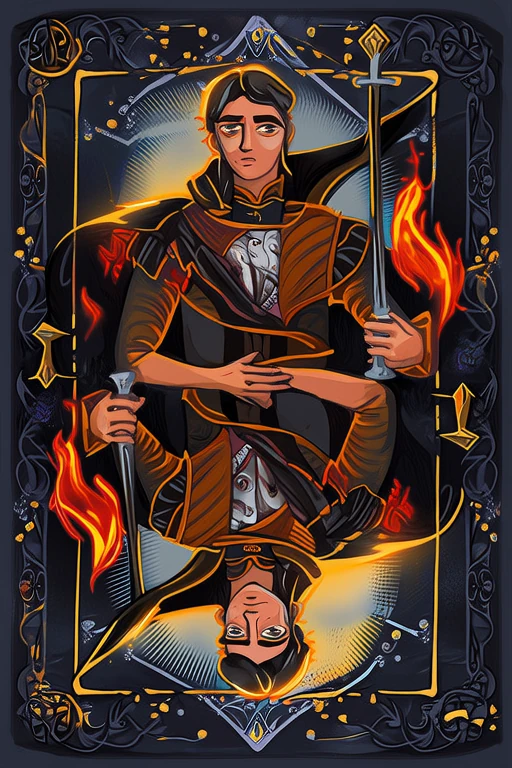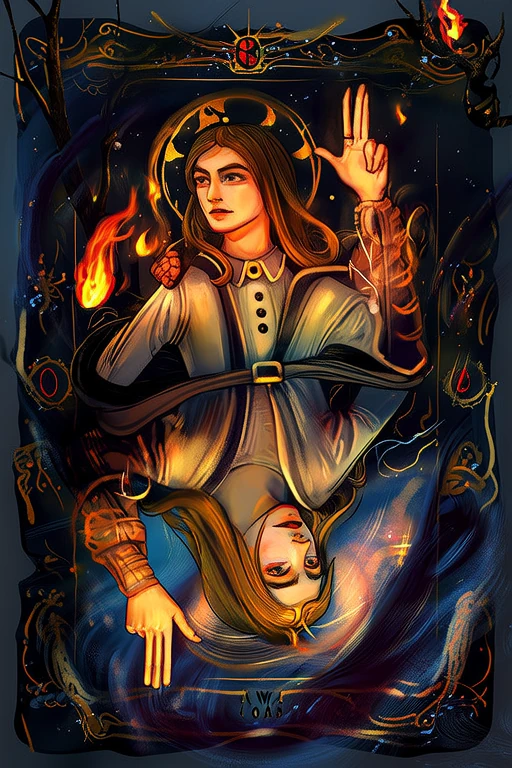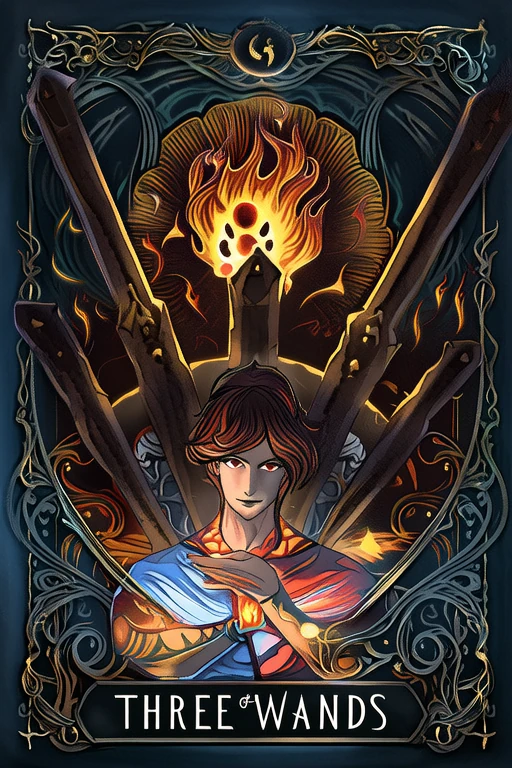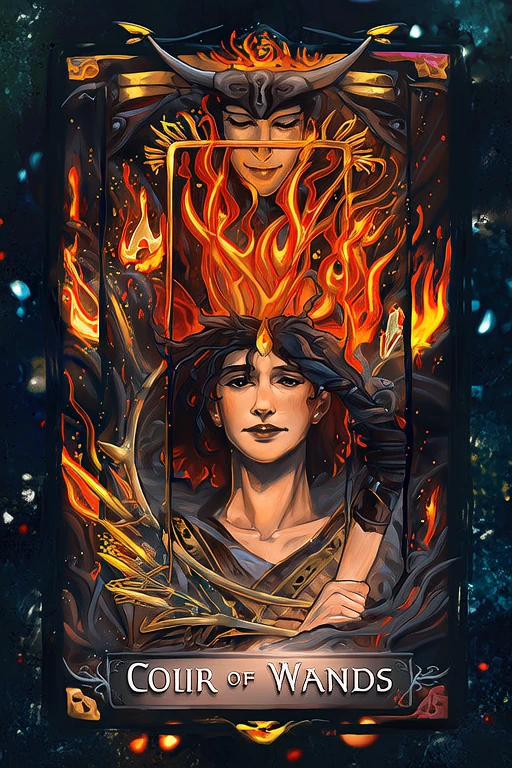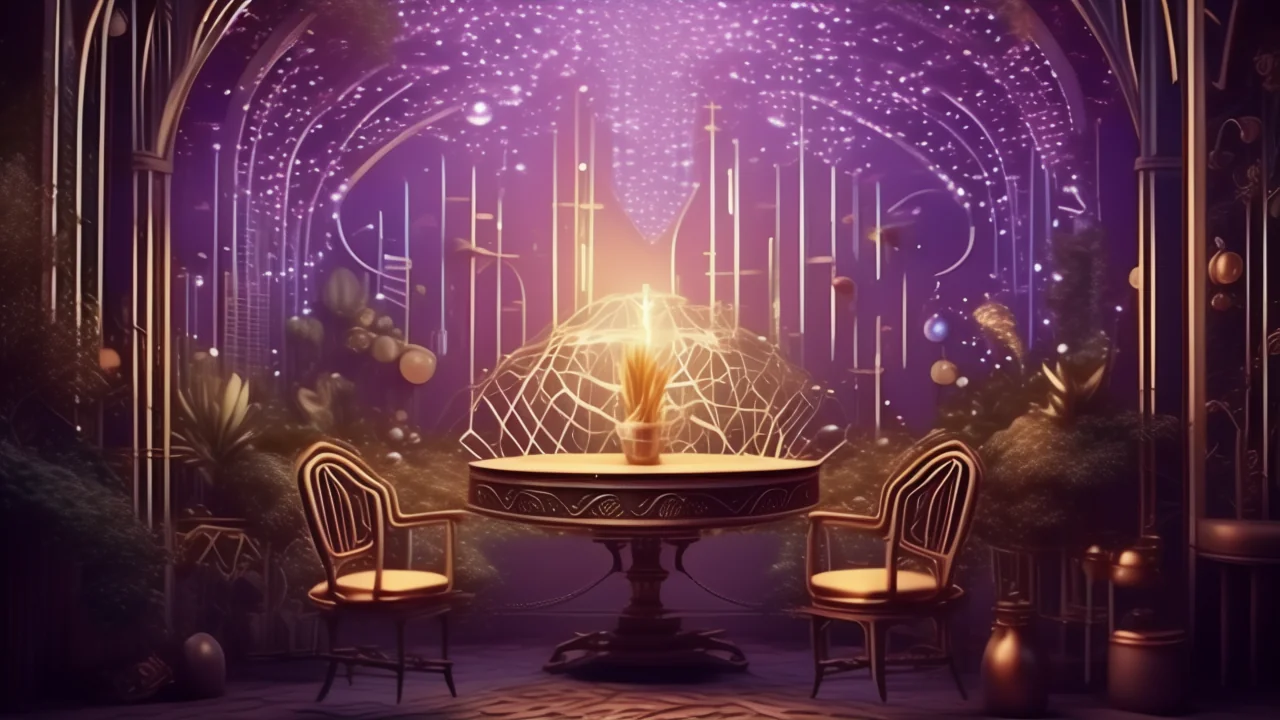
Five of Wands
Discover the deep meaning of Five of Wands with our free AI-powered tarot interpretation. Get instant, accurate readings based on advanced tarot knowledge.
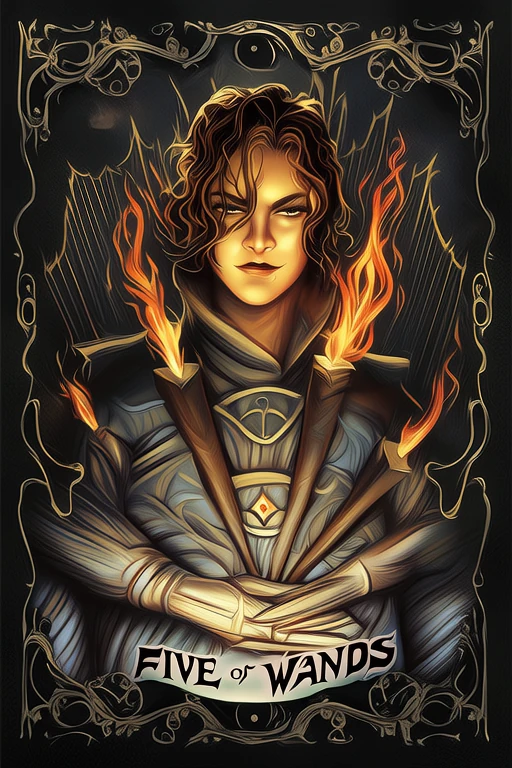
Keywords
Upright Meaning
Conflict, rivalry, disagreement
Reversed Meaning
Inner conflict, conflict avoidance, tension release
Full Interpretation
The Five of Wands represents conflict, competition, and healthy rivalry.
In-Depth Analysis
📜 Historical Background
The Five of Wands, also known as 'Five of Rods' in some decks, is a Minor Arcana card from the suit of Wands in traditional tarot. It is part of the 56-card Minor Arcana, which is divided into four suits—Wands, Cups, Swords, and Pentacles—each containing cards numbered Ace through Ten, plus four court cards: Page, Knight, Queen, and King. The origins of the tarot date back to 15th-century Europe, particularly Italy and France, where tarot cards were initially used for playing games before evolving into tools for divination and spiritual insight during the 18th and 19th centuries.
In early tarot decks such as the Visconti-Sforza and the Marseille Tarot, the Five of Wands was often depicted as a scene of conflict or competition. In the Marseille tradition, the card typically shows five figures holding wands or staves, seemingly engaged in a skirmish or mock battle. These images were inspired by medieval European imagery of jousting, martial training, and communal games, which were common forms of both entertainment and physical preparation for knights and commoners alike.
As tarot evolved into a mystical and esoteric tool, particularly under the influence of the Hermetic Order of the Golden Dawn in the late 19th century, the symbolism of the Five of Wands was reinterpreted through a more spiritual and psychological lens. The Golden Dawn associated the card with strife and conflict, particularly internal or interpersonal struggles related to ambition, competition, and the assertion of will.
Arthur Edward Waite and Pamela Colman Smith’s Rider-Waite-Smith Tarot (1909) further solidified the card’s imagery as we know it today. In this deck, the Five of Wands presents five young men engaged in a chaotic but non-lethal contest, symbolizing minor conflicts, rivalries, and the need to navigate disagreements without permanent harm. This depiction emphasizes the idea that not all conflict is destructive—some forms of competition can lead to growth and self-improvement.
Culturally, the Five of Wands resonates with the archetype of the warrior or competitor, and its themes are echoed in myths and legends across various cultures. In Norse mythology, it can be likened to Thor’s trials or the duels of honor among warriors. In Greek mythology, the labors of Hercules or the competitions in the Olympic games reflect similar themes of challenge and personal development through contest.
Over time, different tarot decks have offered unique interpretations of the Five of Wands. The Thoth Tarot by Aleister Crowley renames the card 'Strife' and associates it with Mars in Leo, highlighting its fiery, assertive nature. Modern decks often maintain the core theme of competition and conflict but may present it through more abstract or symbolic imagery, reflecting contemporary understandings of struggle and personal development.
The Five of Wands continues to be a powerful symbol of challenge, growth, and the necessity of navigating interpersonal friction. Its evolution from a simple game piece to a deeply symbolic tool of insight reflects the broader transformation of tarot as a spiritual and psychological practice across centuries and cultures.
Symbolism & Imagery
The Five of Wands is rich in symbolic meaning, with each element of the card's imagery contributing to its deeper interpretation. At first glance, the card often depicts a scene of minor conflict—five individuals holding wands or rods, engaged in a struggle or competition. While the scene may appear chaotic, it is not inherently violent. Instead, it symbolizes a clash of energies, ideas, or ambitions that, while challenging, can lead to growth and self-awareness.
**Imagery and Symbolic Elements:** In the Rider-Waite-Smith Tarot, five young men are shown in a tangle of raised wands, locked in what appears to be a playful or symbolic battle. The setting is often outdoors, suggesting that the conflict is visible and public rather than hidden or internal. The wands themselves represent the element of Fire, associated with passion, creativity, willpower, and action. The number five, across all suits in the tarot, traditionally symbolizes conflict, instability, and the need to find balance amidst chaos.
**Colors and Their Meanings:** The color palette of the Five of Wands often includes warm tones like reds, oranges, and yellows, reinforcing the fiery nature of the Wands suit. These colors evoke energy, passion, and movement. Some decks may use contrasting colors to highlight the tension between individuals, such as dark versus light attire or opposing stances, further emphasizing the theme of rivalry or differing perspectives.
**Numerological and Elemental Significance:** The number five is associated with change, unpredictability, and the disruption of harmony. In numerology, it is a number of freedom, adventure, and transformation, but also of instability and inner conflict. Combined with the suit of Wands (element of Fire), the card embodies the dynamic energy of competition and the need to assert oneself in a world full of challenges.
**Cultural Interpretations:** Across different cultures and tarot traditions, the Five of Wands may be interpreted with slight variations. In some European traditions, the card is seen as a symbol of playful rivalry or sport, reflecting the historical context of jousting tournaments and martial games. In contrast, Eastern or more introspective interpretations might focus on internal conflicts, such as competing desires or the struggle to maintain personal integrity amidst external pressures.
**Upright Meaning:** In a tarot reading, the upright Five of Wands typically signifies conflict, competition, or disagreement. This may manifest as interpersonal disputes, professional rivalries, or internal struggles between differing desires or goals. However, the card also suggests that these conflicts are not necessarily destructive; they can be opportunities for growth, learning, and the strengthening of character.
**Reversed Meaning:** When reversed, the Five of Wands may indicate the resolution of a conflict, the avoidance of confrontation, or the exhaustion that comes after a prolonged struggle. It can also suggest that the querent is beginning to find a way to navigate disagreements more constructively or is stepping back from unnecessary competition.
**Connection to Other Cards:** The Five of Wands is part of the sequence of Fives in the Minor Arcana, each of which represents a form of conflict or challenge. The Five of Cups deals with emotional loss, the Five of Swords with intellectual or verbal conflict, and the Five of Pentacles with material hardship. Together, these cards illustrate the various ways in which conflict can manifest in life. In the Major Arcana, the card is most closely related to The Chariot, which also deals with overcoming obstacles and asserting one’s will, but with a more victorious and determined outcome.
Ultimately, the Five of Wands serves as a reminder that not all conflict is negative. Through competition and challenge, individuals can discover their strengths, clarify their goals, and develop resilience. It encourages the querent to engage with life’s battles with integrity, courage, and a willingness to grow from the experience.
Psychological Insights
From a psychological perspective, the Five of Wands can be interpreted as a representation of inner conflict, competition, and the process of individuation—the integration of the self through the reconciliation of opposing forces. Carl Jung, the Swiss psychiatrist and founder of analytical psychology, viewed conflict and struggle as essential components of personal growth. He believed that the psyche is composed of various archetypes—universal symbols and patterns that influence human behavior. The Five of Wands aligns closely with the archetype of the Warrior or Competitor, who must navigate challenges, assert their will, and overcome obstacles to achieve personal development.
In modern life, the Five of Wands is particularly relevant in situations involving interpersonal dynamics, such as workplace competition, team conflicts, or social disagreements. It reflects the reality that not all relationships or environments are harmonious, and that friction is a natural part of human interaction. The card encourages individuals to approach these situations with awareness, discernment, and resilience. Rather than avoiding conflict, the Five of Wands suggests that engaging with it—whether through negotiation, assertiveness, or strategic thinking—can lead to greater clarity and self-mastery.
On a personal growth level, the card invites introspection regarding one’s motivations, boundaries, and sense of identity. It may indicate that the querent is facing internal struggles—perhaps between different aspects of the self, conflicting desires, or competing priorities. In this context, the Five of Wands serves as a call to examine these tensions and find a path forward that honors both personal integrity and relational harmony.
In therapeutic and counseling settings, the Five of Wands can be a valuable tool for exploring how individuals handle conflict and competition. It may be used to identify patterns of behavior—such as tendencies to avoid confrontation, engage in unnecessary battles, or become overly invested in winning at the expense of relationships. Counselors and coaches may use the card to guide clients toward healthier conflict resolution strategies, improved communication, and increased emotional intelligence.
In modern spiritual practices, the Five of Wands is often used in meditations or rituals aimed at building inner strength, clarifying intentions, and releasing unnecessary struggles. Some practitioners use the card as a reminder that not all battles are worth fighting and that discernment is key in choosing which conflicts to engage with. Others incorporate the card into shadow work—exploring the parts of the self that may be resistant to cooperation, overly aggressive, or fearful of competition.
Ultimately, the Five of Wands serves as a mirror to the human experience of navigating challenges, asserting one’s will, and learning from the inevitable friction of life. Whether interpreted as a literal external conflict or a metaphorical internal struggle, the card encourages growth through engagement, resilience, and the pursuit of balance amidst chaos.
Correspondences
The Five of Wands is deeply connected to astrological, elemental, and metaphysical correspondences that enhance its symbolic meaning and provide additional layers of interpretation for practitioners and seekers alike. In the Hermetic system, the card is associated with the astrological sign Leo and is ruled by Mars, the planet of action, aggression, and assertion. This planetary and zodiacal influence underscores the card’s themes of competition, courage, and the dynamic assertion of will.
**Astrological Influences:** As Mars in Leo, the Five of Wands embodies the fiery energy of Leo’s passion and charisma combined with Mars’ drive and combativeness. This astrological correspondence suggests a person or situation marked by boldness, theatricality, and a desire to stand out or win. It reflects the need to assert individuality while navigating the challenges of ego, pride, and rivalry.
**Elemental Associations:** The Five of Wands belongs to the suit of Wands, which is governed by the element of Fire. Fire represents inspiration, creativity, ambition, and the primal force of action. Fire energy is dynamic and outward-moving, aligning with the card’s themes of movement, struggle, and the assertion of personal will.
**Gemstones and Crystals:** Certain gemstones and crystals resonate with the energy of the Five of Wands. Carnelian, known for boosting courage and motivation, is particularly aligned with the card’s fiery energy. Red jasper supports endurance and strength, while tiger’s eye enhances confidence and strategic thinking. These stones can be used in meditation, carried for empowerment, or placed on an altar to amplify the card’s themes.
**Herbs and Essential Oils:** Herbs associated with Mars and Fire energy include cayenne, ginger, and cinnamon, which are often used in spells for protection, energy, and success in competition. Essential oils such as clove, black pepper, and rosemary can be diffused or used in rituals to invoke the assertive and stimulating qualities of the Five of Wands.
**Seasonal and Temporal Correspondences:** The card is linked to the summer season, particularly late summer, when the sun is strong, and energy is at its peak. It is also associated with the midday hours, a time of heightened activity and visibility, reinforcing the idea of open, public conflict or competition.
**Chakra Connections:** The Five of Wands resonates with the Solar Plexus Chakra, which governs personal power, confidence, and self-esteem. It can also connect to the Root Chakra, grounding the querent in their physical strength and survival instincts during times of challenge.
**Numerological Significance:** The number five, across all suits in the tarot, signifies change, instability, and the disruption of harmony. In numerology, five is a number of adventure, freedom, and transformation, but also of unpredictability and internal conflict. In the context of the Five of Wands, it emphasizes the need to navigate challenges with adaptability and resilience.
❓ Frequently Asked Questions
The Five of Wands is a card that often raises questions, especially among those new to tarot. Its themes of conflict, competition, and struggle can be misinterpreted as purely negative, but in reality, the card offers a nuanced perspective on how challenges can lead to growth and self-awareness. Below are some of the most frequently asked questions about the Five of Wands, along with clarifications and professional insights for deeper understanding.
**What Does the Five of Wands Mean in a Love Reading?** In love readings, the Five of Wands typically indicates tension or disagreements within a relationship. It may suggest that the couple is experiencing frequent arguments, misunderstandings, or differences in values or goals. However, the card does not necessarily predict the end of a relationship. Instead, it highlights the need for open communication, compromise, and the recognition that some level of friction is natural in any partnership. For singles, the card may indicate competition for affection or the presence of multiple romantic options, requiring discernment and clarity.
**Does the Five of Wands Always Mean Conflict?** While the Five of Wands is primarily associated with conflict, it doesn’t always indicate a negative or destructive struggle. The card can represent healthy competition, constructive debate, or the process of asserting one’s will in a challenging environment. It often suggests that the querent is navigating a situation where multiple perspectives or energies are in motion, and that resolution will come through engagement rather than avoidance.
**Is the Five of Wands a Yes or No Card?** In yes-or-no readings, the Five of Wands generally leans toward a 'no' or 'not yet' answer. It suggests that the situation is still in flux, with unresolved issues or competing forces at play. It advises the querent to take time to assess the dynamics at work before making a decision or taking action.
**What Does the Five of Wands Mean in a Career Reading?** In career contexts, the Five of Wands often points to workplace competition, office politics, or differing opinions on how to approach a project. It may indicate that the querent is dealing with colleagues who have conflicting ideas or that they are feeling the pressure of a high-stakes environment. The card encourages resilience, adaptability, and the ability to stand firm in one’s convictions while remaining open to collaboration.
**How Should Beginners Interpret the Five of Wands?** Beginners often misinterpret the Five of Wands as purely negative, assuming that it always brings bad news. However, it is essential to understand that the card is about navigating challenges rather than predicting failure. It teaches that not all conflict is harmful and that sometimes, struggle is necessary for growth. A helpful approach is to ask: 'What am I competing with or against?' or 'Where in my life am I facing friction that requires resolution?'
**Professional Reading Techniques and Spreads** For professional tarot readers, the Five of Wands works well in spreads that explore conflict resolution, decision-making, or interpersonal dynamics. It is particularly effective in a three-card spread representing past, present, and future, where it may indicate the emergence of a challenge, the current state of tension, and the potential resolution. In a relationship reading, placing the Five of Wands alongside Cups or Swords cards can reveal the emotional or communicative aspects of the conflict.
**How Does the Five of Wands Interact with Other Cards?** When the Five of Wands appears with other Wands cards, it often intensifies the theme of competition or action. With Cups, it may indicate emotional conflict; with Swords, it could suggest verbal disputes or intellectual disagreements; and with Pentacles, it may reflect material or financial competition. In combination with Major Arcana cards like The Chariot or The Devil, it can highlight themes of willpower, control, and the need to harness inner strength.
**Practical Advice for Interpretation in Different Contexts** When interpreting the Five of Wands, it is crucial to consider the surrounding cards and the specific context of the question. In a health reading, it may indicate stress or overexertion. In a legal or business matter, it could point to negotiations or disputes. The key is to recognize that the card is not about permanent defeat but rather about navigating temporary challenges with resilience and strategic thinking.
Practical Readings
Love Reading – Free • Online • AI • Instant • Accurate
In love, Five of Wands upright: Conflict, rivalry, disagreement. Reversed: Inner conflict, conflict avoidance, tension release.
Career Reading – Free • Online • AI • Instant • Accurate
For career, Five of Wands upright: Conflict, rivalry, disagreement. Reversed: Inner conflict, conflict avoidance, tension release.
Yes‑No Reading – Free • Online • AI • Instant • Accurate
As a quick yes‑no: upright tends toward “yes”, reversed leans “no”—interpret within your question’s context.
FAQ
What does Five of Wands mean in tarot?
Five of Wands represents conflict, rivalry, disagreement. This card encourages The Five of Wands represents conflict, competition, and healthy rivalry.
What is Five of Wands reversed meaning?
When Five of Wands appears reversed, it signifies inner conflict, conflict avoidance, tension release. Consider areas that may require adjustment or release.
Is Five of Wands a positive card?
Five of Wands is generally considered a neutral to positive card, representing conflict, rivalry, disagreement.
What should I do if I draw Five of Wands?
If you draw Five of Wands, focus on conflict, rivalry, disagreement. Align actions with the card’s upright energy.
How do I interpret Five of Wands in a love reading?
In love readings, Five of Wands suggests conflict, rivalry, disagreement in relationships. Consider how conflict and rivalry apply to your situation.
What does Five of Wands mean in a love reading?
In love, Five of Wands points to conflict, rivalry, disagreement when upright and inner conflict, conflict avoidance, tension release reversed. Reflect on relational balance & authenticity.
How is Five of Wands interpreted in career?
For career, Five of Wands upright highlights conflict, rivalry, disagreement while reversed warns of inner conflict, conflict avoidance, tension release—adjust planning & execution.
What is the financial meaning of Five of Wands?
Financially, Five of Wands suggests conflict, rivalry, disagreement potential; reversed indicates inner conflict, conflict avoidance, tension release—use prudent pacing.
Is Five of Wands a yes or no card?
Five of Wands is generally a context-dependent when upright; reversed leans toward hesitation or NO—apply to the nuance of your question.
References
References
- Encyclopaedia Britannica – Tarot
Historical overview and cultural context of tarot cards.
- Wikipedia – Tarot
General reference on tarot history, structure, and usage.
- Biddy Tarot – Tarot Card Meanings
Widely cited interpretations and learning resources.
- Labyrinthos – Tarot Card Meanings
Educational articles on major and minor arcana.
